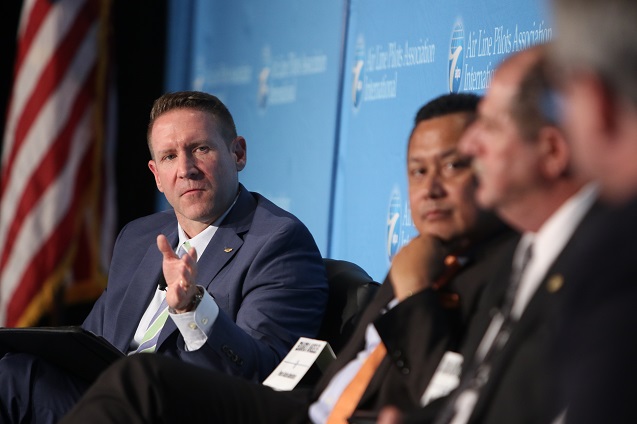August 24, 2016
Pilots Discuss Ways to Increase Runway Safety

Aviation Safety vice chairman Capt. Steve Jangelis (left) directs a question to panelists.
ALPA Aviation Safety vice chairman Capt. Steve Jangelis (Delta) gathered aviation experts to discuss runway safety issues at the Air Safety Forum, including the impact of airport modernization and construction efforts, ramp operations, and methods to improve surface movement at airfields.
“An airport typically looks like an airport, until it’s under construction,” said David Siewart, the chairman of the Airport Construction Advisory Council, and Air Traffic manager at New York’s Kennedy Airport. “We listen to the feedback of pilots to give them the tools they need to operate safely and as a team, bring in pilots, controllers, and many more early in the collaboration process to make the airport as safe an environment as possible.”
FAA Associate Administrator for Airports Eduardo Angeles stated that the trend for airport construction and improvements will continue to increase for the foreseeable future, so pilots need to be ready to adapt and help both the FAA and airports by providing their insight.
Angeles said the government has made major financial investments into infrastructure improvements in and around airports and efforts to eliminate hazards within designated Runway Safety Areas, mitigate runway incursions, and ensure a “return on investment” with safe travel for the flying public.
FAA Vice President for Safety and Technical Training Terry Biggio reiterated the importance of collaboration in managing safety in an ever-changing airport environment, and how about simple changes—like closing a runway—can have a multitude of implications on operations, from the inconvenience of longer taxis to adjusting emergency procedures.
Dan Bartlett, the senior Transportation Safety specialist for the NTSB, dove into “the deeper causes of runway incursions,” detailing the Board’s development of a runway incursion special investigation report to identify incursions. The NTSB is involving multiple groups—including ALPA—to identify best practices to combat the slight uptick in incursions in recent years.
One cause for that uptick could be construction NOTAMs, an area where Siewart stated that there’s still work to done. “The marrying of ICAO standards and FAA standards is an ongoing process,” he said. “There are more initiatives coming down the road as we work with ICAO to better sync our standards.”
“So stay tuned for a NOTAM discussion at next year’s Forum,” Jangelis said in closing.
Read additional ASF coverage and join the conversation on social media using #ASF62.
-###-

